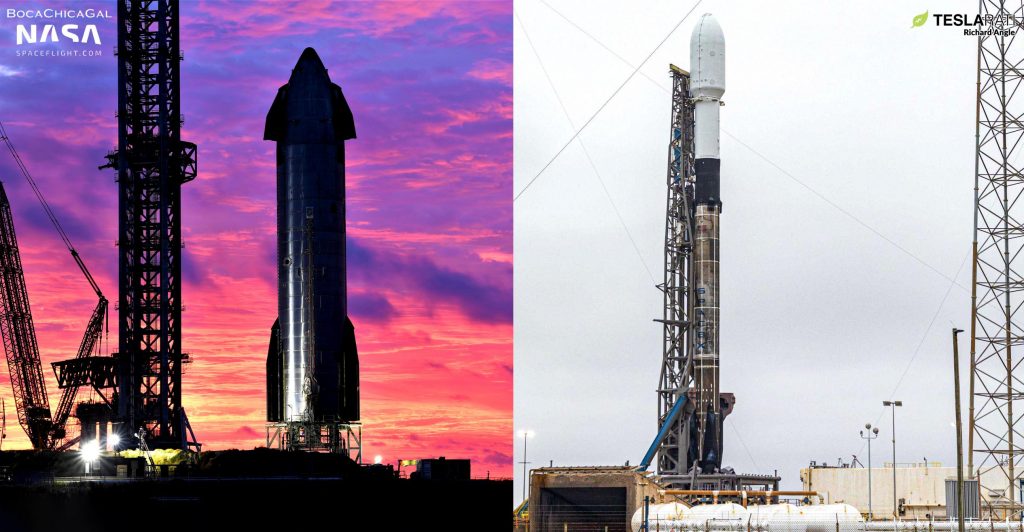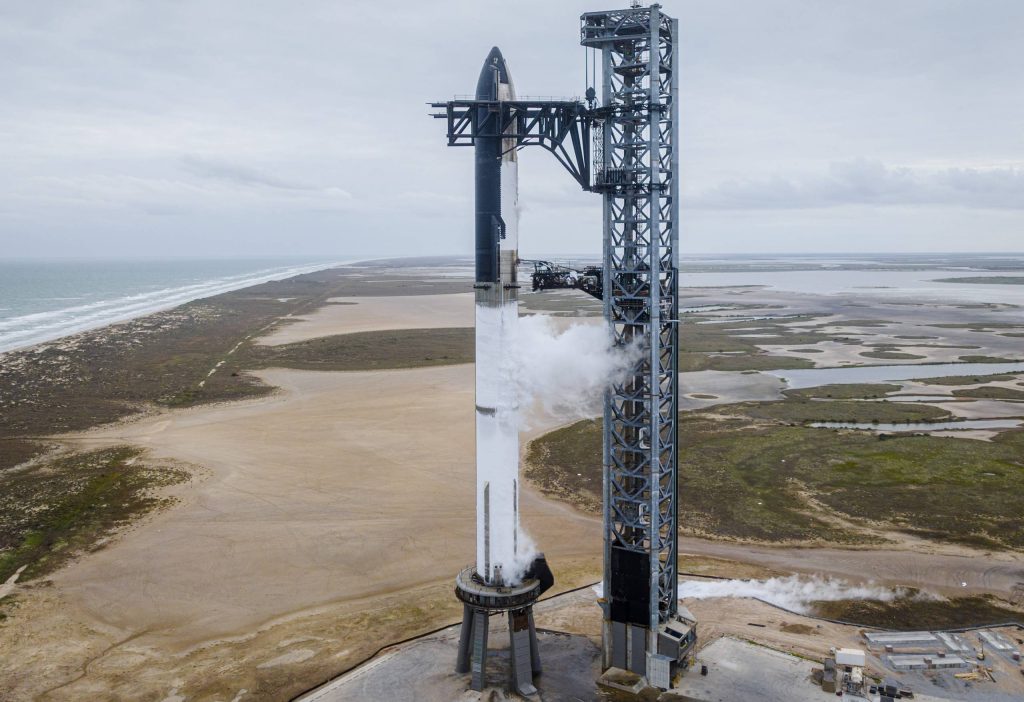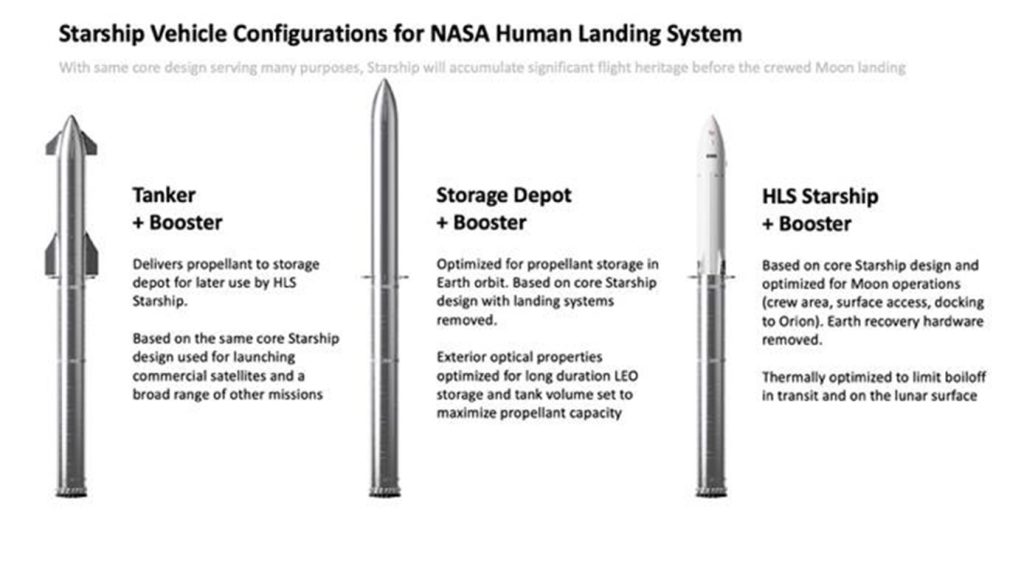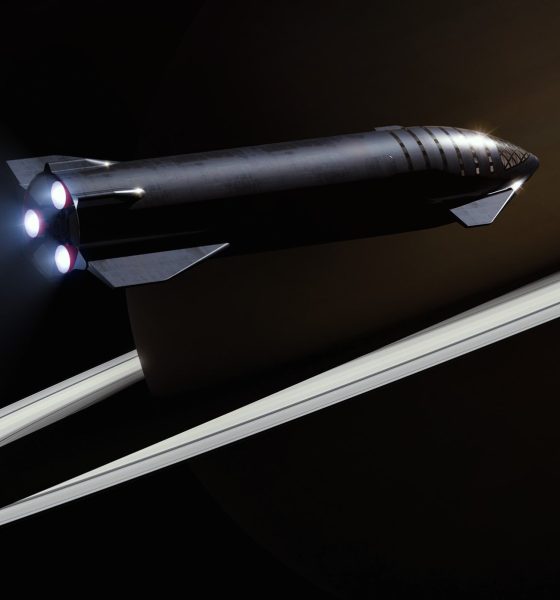SpaceX CEO Elon Musk says that the company could eventually develop an expendable version of its next-generation Starship rocket.
Starship is extraordinarily ambitious. Even before considering the unproven concepts of orbital propellant refilling and full, rapid reusability that are central to the full system, Starship is a beast. The rocket measures 120 meters (~390 ft) tall and is theoretically capable of producing up to 7590 tons (~16.7M lbf) of thrust at sea level. It’s larger, taller, heavier, and more powerful than any other launch vehicle in history. 33 Raptor 2 engines power Starship’s Super Heavy booster – also more than any other rocket.
Once optimized, SpaceX says that Starship can launch up to 150 tons (330,000 lbs) to low Earth orbit while still recovering the orbital ship and suborbital booster for reuse. CEO Elon Musk has stated that Starship reuse will eventually take hours, enabling multiple flights per day for each ship and booster and dropping the marginal cost of each launch to just a few million dollars.
In comparison, SpaceX’s workhorse Falcon 9 rocket uses simpler Merlin 1D engines, has just 10 of those engines to Starship’s 39 Raptors, produces about 10 times less thrust at liftoff, and can launch about 11% as much payload to orbit while expending its upper stage. Even then, Musk reported in mid-2020 that the marginal cost of a Falcon 9 launch was $15 million – impressively low but still a vivid demonstration of just how far Starship has to go.

The update that's rolling out to the fleet makes full use of the front and rear steering travel to minimize turning circle. In this case a reduction of 1.6 feet just over the air— Wes (@wmorrill3) April 16, 2024
Simply ensuring that Starship can reach orbit at all is a major challenge. Successfully recovering Starship and Super Heavy after the fact may be an even bigger challenge and cannot be fully demonstrated until the rocket can consistently reach orbit. SpaceX won’t be able to reuse Starship until it can consistently recover ships and boosters from orbital launches. And there’s no guarantee that early prototypes will be reusable even if they’re recovered.
Until reusability is demonstrated, every “Starship upper stage” will be functionally expendable whether or not Elon Musk wants it to be. Musk likely means that SpaceX may or may not decide to develop a Starship upper stage custom-built for expendable missions. Such a stage would likely take Starship, remove everything extraneous, and reduce its mass as much as possible. Musk has proposed something similar before, noting that SpaceX could develop a “lightened” version of Starship “with no heat shield or fins/legs” for expendable, interplanetary launches.

Further to the contrary, SpaceX’s Starbase factory is already building multiple intentionally-expendable Starships. Ship 26 and Ship 27 feature no thermal protection, have no heat shield tiles, and will not be fitted with flaps, making them impossible to recover or reuse. More likely than not, they will be used to test other crucial Starship technologies like orbital refilling and cryogenic fluid management.
Meanwhile, SpaceX’s multibillion-dollar contract to use Starship to return NASA astronauts to the Moon revolves around a depot ship variant that will store propellant in orbit and cannot return to Earth. The first few Starship Moon landers may also be functionally expendable and only used for one astronaut landing apiece. In short, SpaceX already has extensive plans to build variants of Starship that are either fully expendable or can only be reused in orbit.

Single-use Starships
In early 2023, SpaceX updated the Starship section of its website, revealing that an expendable version of the rocket will be able to launch up to 250 metric tons (~550,000 lbs) to low Earth orbit in a single launch. Saturn V, the next most capable expendable rocket, could launch up to 118 tons (~260,000 lbs) to LEO and cost $1-2 billion per launch. SpaceX publicly advertising the expendable performance of Starship unsurprisingly confirms that the company is considering all of the capabilities its new launch system will offer.
And Starship’s expendable capabilities are significant. Constructed piece by piece over dozens of launches, the International Space Station weighs about 420 tons (~925,000 lbs). Two expendable Starships could launch more usable mass to LEO – truly revolutionary if SpaceX can make Starship launches frequent and routine.

Elon Musk
Elon Musk’s X will start using a Tesla-like software update strategy
The initiative seems designed to accelerate updates to the social media platform, while maintaining maximum transparency.

Elon Musk’s social media platform X will adopt a Tesla-esque approach to software updates for its algorithm.
The initiative seems designed to accelerate updates to the social media platform, while maintaining maximum transparency.
X’s updates to its updates
As per Musk in a post on X, the social media company will be making a new algorithm to determine what organic and advertising posts are recommended to users. These updates would then be repeated every four weeks.
“We will make the new 𝕏 algorithm, including all code used to determine what organic and advertising posts are recommended to users, open source in 7 days. This will be repeated every 4 weeks, with comprehensive developer notes, to help you understand what changed,” Musk wrote in his post.
The initiative somewhat mirrors Tesla’s over-the-air update model, where vehicle software is regularly refined and pushed to users with detailed release notes. This should allow users to better understand the details of X’s every update and foster a healthy feedback loop for the social media platform.
xAI and X
X, formerly Twitter, has been acquired by Elon Musk’s artificial intelligence startup, xAI last year. Since then, xAI has seen a rapid rise in valuation. Following the company’s the company’s upsized $20 billion Series E funding round, estimates now suggest that xAI is worth tens about $230 to $235 billion. That’s several times larger than Tesla when Elon Musk received his controversial 2018 CEO Performance Award.
As per xAI, the Series E funding round attracted a diverse group of investors, including Valor Equity Partners, Stepstone Group, Fidelity Management & Research Company, Qatar Investment Authority, MGX, and Baron Capital Group, among others. Strategic partners NVIDIA and Cisco Investments also continued support for building the world’s largest GPU clusters.
News
Tesla FSD Supervised wins MotorTrend’s Best Driver Assistance Award
The decision marks a notable reversal for the publication from prior years, with judges citing major real-world improvements that pushed Tesla’s latest FSD software ahead of every competing ADAS system.

Tesla’s Full Self-Driving (Supervised) system has been named the best driver-assistance technology on the market, earning top honors at the 2026 MotorTrend Best Tech Awards.
The decision marks a notable reversal for the publication from prior years, with judges citing major real-world improvements that pushed Tesla’s latest FSD software ahead of every competing ADAS system. And it wasn’t even close.
MotorTrend reverses course
MotorTrend awarded Tesla FSD (Supervised) its 2026 Best Tech Driver Assistance title after extensive testing of the latest v14 software. The publication acknowledged that it had previously criticized earlier versions of FSD for erratic behavior and near-miss incidents, ultimately favoring rivals such as GM’s Super Cruise in earlier evaluations.
According to MotorTrend, the newest iteration of FSD resolved many of those shortcomings. Testers said v14 showed far smoother behavior in complex urban scenarios, including unprotected left turns, traffic circles, emergency vehicles, and dense city streets. While the system still requires constant driver supervision, judges concluded that no other advanced driver-assistance system currently matches its breadth of capability.
Unlike rival systems that rely on combinations of cameras, radar, lidar, and mapped highways, Tesla’s FSD operates using a camera-only approach and is capable of driving on city streets, rural roads, and freeways. MotorTrend stated that pure utility, the ability to handle nearly all road types, ultimately separated FSD from competitors like Ford BlueCruise, GM Super Cruise, and BMW’s Highway Assistant.
High cost and high capability
MotorTrend also addressed FSD’s pricing, which remains significantly higher than rival systems. Tesla currently charges $8,000 for a one-time purchase or $99 per month for a subscription, compared with far lower upfront and subscription costs from other automakers. The publication noted that the premium is justified given FSD’s unmatched scope and continuous software evolution.
Safety remained a central focus of the evaluation. While testers reported collision-free operation over thousands of miles, they noted ongoing concerns around FSD’s configurable driving modes, including options that allow aggressive driving and speeds beyond posted limits. MotorTrend emphasized that, like all Level 2 systems, FSD still depends on a fully attentive human driver at all times.
Despite those caveats, the publication concluded that Tesla’s rapid software progress fundamentally reshaped the competitive landscape. For drivers seeking the most capable hands-on driver-assistance system available today, MotorTrend concluded Tesla FSD (Supervised) now stands alone at the top.
News
Elon Musk’s Grokipedia surges to 5.6M articles, almost 79% of English Wikipedia
The explosive growth marks a major milestone for the AI-powered online encyclopedia, which was launched by Elon Musk’s xAI just months ago.

Elon Musk’s Grokipedia has grown to an impressive 5,615,201 articles as of today, closing in on 79% of the English Wikipedia’s current total of 7,119,376 articles.
The explosive growth marks a major milestone for the AI-powered online encyclopedia, which was launched by Elon Musk’s xAI just months ago. Needless to say, it would only be a matter of time before Grokipedia exceeds English Wikipedia in sheer volume.
Grokipedia’s rapid growth
xAI’s vision for Grokipedia emphasizes neutrality, while Grok’s reasoning capabilities allow for fast drafting and fact-checking. When Elon Musk announced the initiative in late September 2025, he noted that Grokipedia would be an improvement to Wikipedia because it would be designed to avoid bias.
At the time, Musk noted that Grokipedia “is a necessary step towards the xAI goal of understanding the Universe.”
Grokipedia was launched in late October, and while xAI was careful to list it only as Version 0.1 at the time, the online encyclopedia immediately earned praise. Wikipedia co-founder Larry Sanger highlighted the project’s innovative approach, noting how it leverages AI to fill knowledge gaps and enable rapid updates. Netizens also observed how Grokipedia tends to present articles in a more objective manner compared to Wikipedia, which is edited by humans.
Elon Musk’s ambitious plans
With 5,615,201 total articles, Grokipedia has now grown to almost 79% of English Wikipedia’s article base. This is incredibly quick, though Grokipedia remains text-only for now. xAI, for its part, has now updated the online encyclopedia’s iteration to v0.2.
Elon Musk has shared bold ideas for Grokipedia, including sending a record of the entire knowledge base to space as part of xAI’s mission to preserve and expand human understanding. At some point, Musk stated that Grokipedia will be renamed to Encyclopedia Galactica, and it will be sent to the cosmos.
“When Grokipedia is good enough (long way to go), we will change the name to Encyclopedia Galactica. It will be an open source distillation of all knowledge, including audio, images and video. Join xAI to help build the sci-fi version of the Library of Alexandria!” Musk wrote, adding in a later post that “Copies will be etched in stone and sent to the Moon, Mars and beyond. This time, it will not be lost.”










